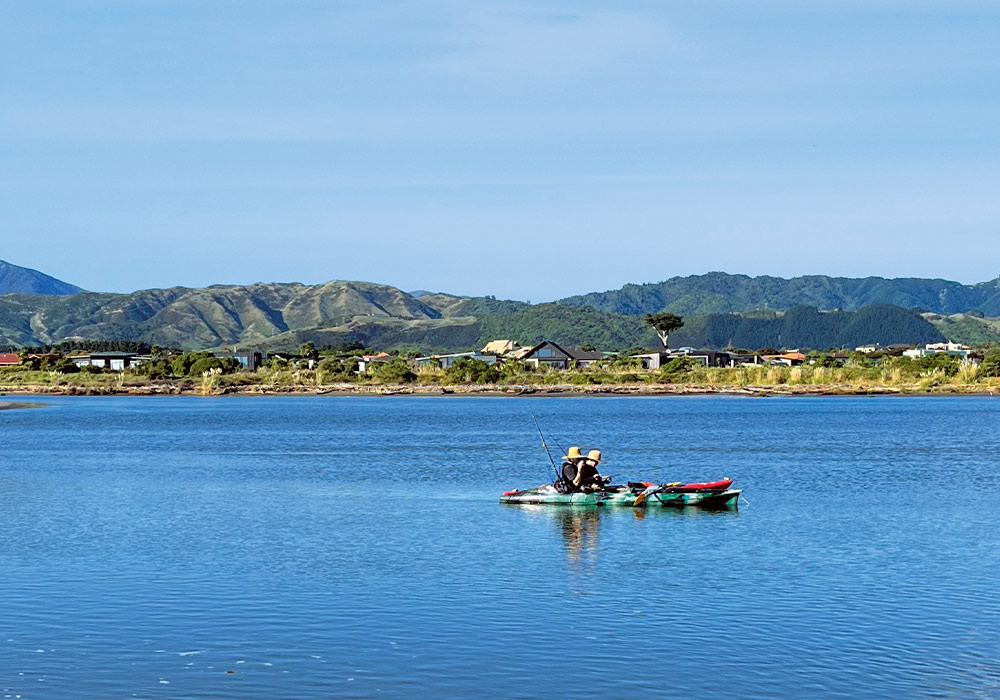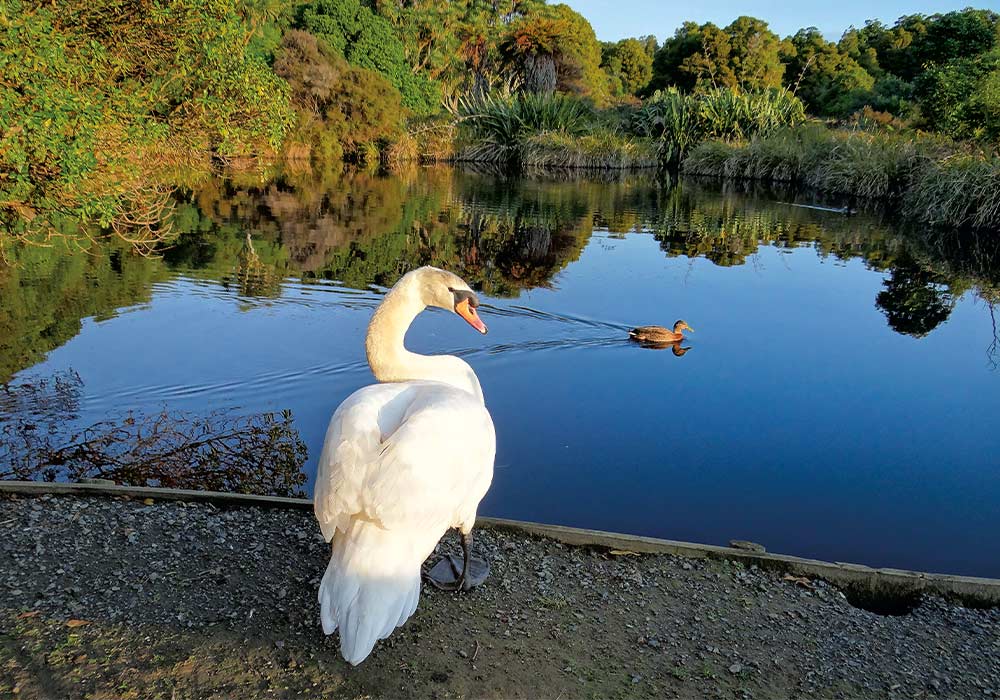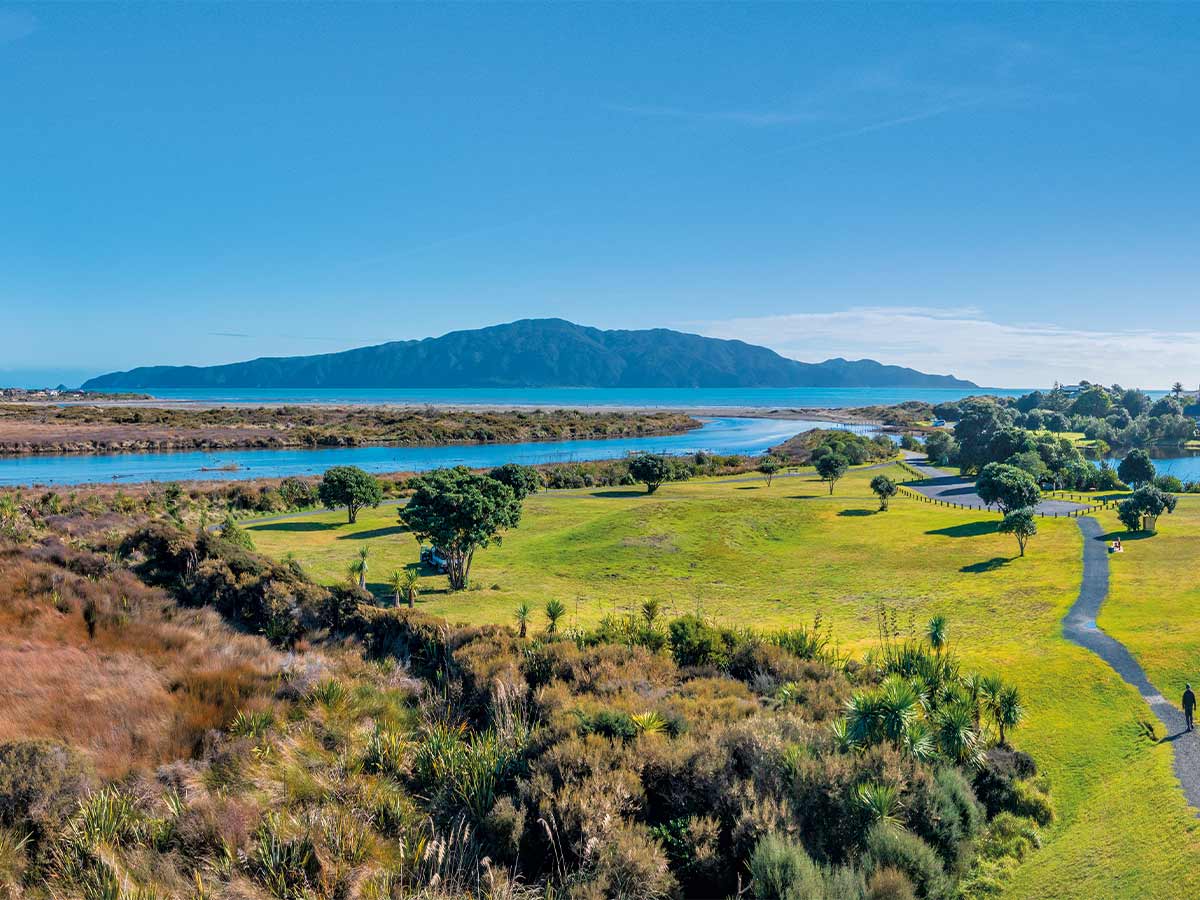The recently opened Wellington roading system affords an uninterrupted drive into the capital, but the old route is still the best way to enjoy the high spots of the Kāpiti Coast, as Jill Malcolm discovers
The Kāpiti Coast, between Ōtaki in the north and Paekākāriki in the south, is fringed by an uninterrupted beach the colour of concrete and a seascape dominated by the lumpy bulk of Kāpiti Island.
The first night we arrived, we parked up at the Ōtaki Golf Club where we received an overview of the town by a group of four who were finishing their round on the 19th hole.
“Ōtaki’s a real go-ahead place,” said one golfer who introduced himself as John. “Have a look at what happening at the Māori University campus. They’re building a pretty impressive complex.”
Education is a powerful dynamic in the town. The striking rebuild of its university, Te Wānanga o Raukawa, is following the guidelines of the International Living Building Challenge, in which the site, energy, materials, and beauty of all the structures contribute positively to the environment. The magnificent central building with its crisscrossed timber façade is certainly eye-catching.
As I examined the building site, a passer-by asked me if I’d seen the new historic church. He was obviously unaware of the oxymoron.
I followed his directions and found Rangiātea, the first Māori church in New Zealand, built in 1851 under the direction of an English missionary called Octavius Hadfield and the great warrior, Te Rauparaha.
An extraordinary blend of Māori and European design, it was decorated inside with elaborate Māori designs and intricate tukutuku panelling. Disastrously, in 1995, a local arsonist burnt it to the ground. Such was its loss that by 2003, an almost exact replica had been built and the church is now as it was – a lasting tribute to both its past and present creators.
Water and wildlife

South of Ōtaki, the Waikanae River spreads into a wide lagoon before it slides into the Tasman Sea. The area is a haven for waders and water birds, a sanctuary and scientific reserve that’s one of the jewels of the Kāpiti Coast.
Over the years, 63 species have been spotted and because it’s in a semi-urban environment, the avian residents are more easily approached than elsewhere. There’s a track around the estuary and out onto the sandspit.
For the last 25 years, local enthusiast Mik Peryer has been conducting tours in the area, which greatly increase the chances of seeing the more regular occupants – Caspian terns, royal spoonbills, shags, dabchicks scaup, herons, and shovelers to name a few. Mik has now written 10 books, some of them for children, that give fascinating insights into the daily doings of his avian friends. RVers can park at the river mouth and observe what the natural world might conjure up overnight.
Heading inland

Inland, there’s another good opportunity to see native species in the natural setting of Ngā Manu Reserve. Fourteen hectares in size, it’s the largest remnant of lowland swamp forest remaining on the Kāpiti Coast.
As well as the birds that come and go, there are walk-through aviaries, reptile enclosures, and a kiwi house. Just outside the park is a two-vehicle POP.
Kāpiti Island is also a haven for flora and fauna. Introduced pests once ravaged the island’s forests until a group of naturalists urged the government to designate it a reserve. The island flourished when it was relieved of its pests. Native forest is regenerating, and native creatures are thriving. In 1928, the last of 2000 goats were shot. Cats were eradicated by 1935 and 220,000 possums were destroyed in the ’80s. By 1996, the last of the rats was gone.
On this last trip, a vicious wind put paid to a visit, but I recall a magic moment from last time. Along the steep track that leads to the 522-metre summit, a soft “tssst” alerted me to the presence of a stitch bird. I sat down to watch and began munching on a sandwich. A kaka suddenly alighted on a branch beside me. I was mesmerised. A moment later, I was all but mugged. The parrot suddenly plunged from its perch and landed on my shoulder. I’ve been knocked over by a feather before but not by a whole bird and it got me (and the kaka) screeching and flapping around in a state of hysteria. The mugger disappeared sans sandwich.
Further up the track, a weka strode stealthily across the path holding in its beak a bright pink mug. A visit to Kāpiti can throw up some unforgettable experiences.
Paekākāriki

As far as human habitation goes, my favourite spot on the coast is Paekākāriki, the zany little village wedged on a narrow ledge between the Tasman Sea and the steep hills of the Akatarawa Range.
Actors, dancers, musicians, filmmakers, artists, and sculptors have chosen to make their homes here. Fighting to keep its old character intact, efforts have been made to jazz things up and make modern use of old buildings. Most notable is the recent rescue from demolition of the pink, 1920s Holtom’s building, an important part of village heritage. It has been restored and the ground floor now houses a deli and a bakery, and the upper floor is an impressive art studio for a dozen local artists.
During the building’s salvage, a thick layer of coal dust was discovered in the ceiling from the steam trains that used to stop alongside. Paekākāriki has a long railway history. The railway station (circa 1886) is protected and services travelling between Paraparaumu and Wellington still stop at the attractive building, which also houses a well-presented museum, a specialist bookshop, and on the platform a signal station.
As I perched outside the Olde Bakery consuming a chocolate friand, an agile-looking French girl joined me at the table. She had just returned from the Escarpment Track, which leaves from the village.
It had taken her three hours, much of it straight uphill.
“There are 500 steps but great views,” she said. “You should do it sometime.”
Not me. There are better ways to find a view.
The final chapter

We stayed at the spacious Paekākāriki Holiday Park, tucked into a corner of Wellington’s favourite playground. The 650-hectare terrain of Queen Elizabeth Park encompasses the last remnant of the muscular sand dunes that once stretched the length of the coast. A great effort is being made to restore them. On the foreshore, the bleached shapes of washed-up tree trunks stick up from the sand like gatherings of ghosts.
We also walked the Coastal Lookout Trail, a small version of the long haul up the Paekākāriki Escarpment, and there was our view. The dunes formation, furred with grasses and stunted trees was evident, their rounded mounds loping up and down the coastline. Beyond was Kāpiti Island shadowed and clear-cut again a pearly white sky. Toy cars hummed down the motorway, and we could see from Farewell Spit to the Kaikōura Mountains.
Keen RV cyclists might enjoy the new shared cycleway/walkway that runs alongside the new motorway from Raumati to Ōtaki. It’s also a bridleway, so you could well come across a horse or two. Separated from the expressway by plantings of flaxes and native bushes, this very popular and well-set-up track also connects with local roads throughout the region.

Accommodation and RV parking
Apart from the well-documented camping camping grounds, POPs, and NZMCA parks on the Kāpiti Coast, there are a surprising number of freedom camping areas. On the north bank at Ōtaki Beach on Kāpiti Lane, there’s an area for six RVs. There are also two areas on Waimea Road, Waikanae. One is on the north side of the stream in Field Way Car Park and the other is on Waimea Road at the beach.
On the bank of the Waimanu Lagoon is a small park close to the water and another spot on Park Avenue has room for only two vehicles.
On the marine parade at Paraparaumu are three parking areas right on the beach. They take two vehicles each so in summer, you need to bag a spot early in the day.
Much ado on the Kāpiti coast
Experience
If you are bold and brave, Fly by Wire is a top adrenalin activity in a one-person plane, secured by a top wire, that zooms over a spectacular canyon near Paekākāriki, The minimum age for flyers is 15 years old.
Cook
Well-known chef and teacher, Ruth Pretty has an orchard property at Te Horo where most weekends cooking school is held at the Ruth Pretty Catering School. If you’re not into cooking, coffee and cakes are available at the Kitchen Shop, which has an interesting range of kitchenware for sale.
Drink
The Tuatara Brewery Tap Room is one of the most popular craft breweries on the Kāpiti Coast and draws beer lovers from all over the region. In an unpretentious environment, beer connoisseurs and casual imbibers can enjoy a pint or two of freshly brewed beer.
See
In park-like surroundings on the Kāpiti Coast is a world-class museum. The cavernous exhibition hall of Southward Car Museum houses a remarkable car collection, which is the largest private collection in New Zealand exhibiting 450 rare vehicles of all descriptions.
Eat
Across the road from Waikanae Beach, Longbeach Tavern is a cool neighbourhood café serving dishes such as caramelised Vietnamese pork belly, eggplant Parmigiana, 13 different types of pizzas, fancy cocktails, and among the desserts one called warm kerfuffle pudding.






